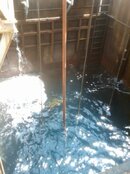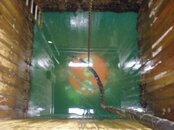Does anybody have a list, or at least the number, of operational DSVs these days? The definition of what defines a DSV can be a little slippery but I would put a permanently installed sat system and moonpool(s) on the list.
What's a Moonpool? A moonpool is a vertical well through the vessel where the diving bell enters the water. They are located roughly amidships, ideally at the most stable point of hull rotation in all axis (also a slippery definition). Most are square or rectangular and are open from the keel to a deck well above the waterline where the bell is launched.
Most moonpools I have seen have a cursor that sits on top of the bell until it reaches the keel. It is designed to keep the lifting cable centered in the moonpool and guide the bell's umbilical.
Many bell handling systems also have two guide cables connected to a weight that is lowered below the bell to reduce twisting at depth. The cables slide through bushings on the bell. Non-rotating cable is used to lift the bell to reduce twisting, but it doesn't eliminate it. Getting the umbilical twisted around the lifting cable causes excessive chaffing, especially at greater depths.
There are sea conditions where the bell can act like a piston in the moonpool. I have seen bells lifted 3-4' and dropped as the swell rolled by. It is not unusual for air (lots of it) to be injected at the bottom of the moonpool to aerate the water as the bell passes. This effectively reduces the water density, thus the bell's buoyancy, until it clears the keel.
Moonpool is term was that was adopted from the offshore drilling industry. They required the most stable point on the vessel to keep their drill string from being tied in knots. They also need a lot of room to work around it. I have heard several stories on where they got the name and I'm not sure I believe any of them.
Does anyone have any decent photos or illustrations? I always had a hard time getting photos of bell handling systems that didn't just look like a jumble of machinery.
What's a Moonpool? A moonpool is a vertical well through the vessel where the diving bell enters the water. They are located roughly amidships, ideally at the most stable point of hull rotation in all axis (also a slippery definition). Most are square or rectangular and are open from the keel to a deck well above the waterline where the bell is launched.
Most moonpools I have seen have a cursor that sits on top of the bell until it reaches the keel. It is designed to keep the lifting cable centered in the moonpool and guide the bell's umbilical.
Many bell handling systems also have two guide cables connected to a weight that is lowered below the bell to reduce twisting at depth. The cables slide through bushings on the bell. Non-rotating cable is used to lift the bell to reduce twisting, but it doesn't eliminate it. Getting the umbilical twisted around the lifting cable causes excessive chaffing, especially at greater depths.
There are sea conditions where the bell can act like a piston in the moonpool. I have seen bells lifted 3-4' and dropped as the swell rolled by. It is not unusual for air (lots of it) to be injected at the bottom of the moonpool to aerate the water as the bell passes. This effectively reduces the water density, thus the bell's buoyancy, until it clears the keel.
Moonpool is term was that was adopted from the offshore drilling industry. They required the most stable point on the vessel to keep their drill string from being tied in knots. They also need a lot of room to work around it. I have heard several stories on where they got the name and I'm not sure I believe any of them.
Does anyone have any decent photos or illustrations? I always had a hard time getting photos of bell handling systems that didn't just look like a jumble of machinery.






